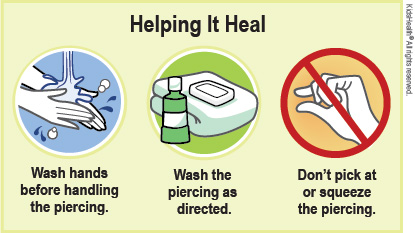Infected Piercing: Caring for Your Child
A piercing can become infected when germs get into broken skin. Signs of infection include pus, bleeding, pain, redness, or swelling. Sometimes pus collects under the skin and forms a lump called an abscess. Infected piercings are common and usually heal well with proper care at home.


-
Do not remove the piercing jewelry unless the doctor tells you to.
-
Always wash hands before cleaning or handling the piercing.
-
Clean the infected piercing as directed:
-
For skin piercings, cleaning should be at least once a day with soap and water, not with hydrogen peroxide. Blot dry with a clean towel.
-
For tongue, cheek, or lip piercings, your child should use an antibacterial, alcohol-free mouthwash after every meal and before bed.
-
If your doctor recommends, spread a thin coat of antibiotic ointment over the piercing as directed.
-
For pain and swelling, hold a warm compress (a clean, wet, warm washcloth) to the piercing for a few minutes.
-
Your child should not pick at or tug the piercing.
-
If the doctor prescribed an antibiotic to take by mouth, give it as directed.

Your child:
-
has symptoms that do not start to get better in 2 days
-
has a fever of 100.4°F (38°C) or higher
-
develops a sore lump near the piercing
-
has increasing redness, swelling, warmth, or soreness at the area

Why do piercings get infected? There is a greater chance that a piercing will get infected if:
-
The person who did the piercing did not use clean methods and/or tools.
-
Your child does not clean the pierced area as directed.
-
Your child swims before the piercing is healed.
-
Your child touches the piercing a lot.
-
The jewelry is too tight.